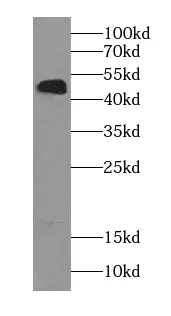ACHE antibody - 100 µg
Host : Rabbit
Clonality: Polyclonal
Clone:
Isotype: IgG
Immunogen: acetylcholinesterase (Yt blood group)
Purity: ≥95% as determined by SDS-PAGE
Form: Liquid
Molecular weight: 71 kDa
Uniprot: P22303
Gene id: 43
Background: Acetylcholinesterase hydrolyzes the neurotransmitter, acetylcholine at neuromuscular junctions and brain cholinergic synapses, and thus terminates signal transmission. It is also found on the red blood cell membranes, where it constitutes the Yt blood group antigen. Acetylcholinesterase exists in multiple molecular forms which possess similar catalytic properties, but differ in their oligomeric assembly and mode of cell attachment to the cell surface. It is encoded by the single ACHE gene, and the structural diversity in the gene products arises from alternative mRNA splicing, and post-translational associations of catalytic and structural subunits. The major form of acetylcholinesterase found in brain, muscle and other tissues is the hydrophilic species, which forms disulfide-linked oligomers with collagenous, or lipid-containing structural subunits. The other, alternatively spliced form, expressed primarily in the erythroid tissues, differs at the C-terminal end, and contains a cleavable hydrophobic peptide with a GPI-anchor site. It associates with the membranes through the phosphoinositide (PI) moieties added post-translationally.
Field of research:
Storage conditions: PBS with 0.02% sodium azide and 50% glycerol pH 7.3, -20°C for 12 months (Avoid repeated freeze
thaw cycles.)
Applications: ELISA, WB, IHC
Dilution: WB: 1:500 - 1:2000; IHC: 1:50 - 1:100
Target: ACHE
Purification: Immunogen affinity purified
Reactivity: Human, Mouse, Rat

Clonality: Polyclonal
Clone:
Isotype: IgG
Immunogen: acetylcholinesterase (Yt blood group)
Purity: ≥95% as determined by SDS-PAGE
Form: Liquid
Molecular weight: 71 kDa
Uniprot: P22303
Gene id: 43
Background: Acetylcholinesterase hydrolyzes the neurotransmitter, acetylcholine at neuromuscular junctions and brain cholinergic synapses, and thus terminates signal transmission. It is also found on the red blood cell membranes, where it constitutes the Yt blood group antigen. Acetylcholinesterase exists in multiple molecular forms which possess similar catalytic properties, but differ in their oligomeric assembly and mode of cell attachment to the cell surface. It is encoded by the single ACHE gene, and the structural diversity in the gene products arises from alternative mRNA splicing, and post-translational associations of catalytic and structural subunits. The major form of acetylcholinesterase found in brain, muscle and other tissues is the hydrophilic species, which forms disulfide-linked oligomers with collagenous, or lipid-containing structural subunits. The other, alternatively spliced form, expressed primarily in the erythroid tissues, differs at the C-terminal end, and contains a cleavable hydrophobic peptide with a GPI-anchor site. It associates with the membranes through the phosphoinositide (PI) moieties added post-translationally.
Field of research:
Storage conditions: PBS with 0.02% sodium azide and 50% glycerol pH 7.3, -20°C for 12 months (Avoid repeated freeze
thaw cycles.)
Applications: ELISA, WB, IHC
Dilution: WB: 1:500 - 1:2000; IHC: 1:50 - 1:100
Target: ACHE
Purification: Immunogen affinity purified
Reactivity: Human, Mouse, Rat

